
Reduced U.S. Funding to Bolivia Reflects Diminishing Influence and Complex Dynamics
February 17, 2011 - Andean Information Network
Written by Erin Hatheway, the Andean Information Network
The U.S. government historically exercised significant political influence through conditioned funding for Bolivia. However, the U.S. budget for Bolivia should shrink substantially in 2012, further limiting an already diminished presence. Reductions in funding and diplomatic involvement could help lay the foundation for an innovative bilateral relationship.
Congress is currently reviewing the Obama administration's FY 2011 State and Foreign Operations Appropriations Bill. The Administration requests $20 million for Bolivian counternarcotics efforts in 2011, while the request for 2012 cuts that figure by 50%. The newly elected, Republican majority in the House of Representatives will most likely advocate further reductions for financial assistance to Bolivia.
The Bureau of International Narcotics and Law Enforcement Affairs (INL) budget requests and legislative appropriations for the past five years belie downward funding trends, but the reduction between the proposed 2011 and 2012 budgets is the most drastic. By U.S. standards, INL Bolivia operations already run on a comparatively reduced budget. Furthermore, the U.S. funding Bolivia receives is significantly less than the two major producers of coca leaf, Peru and Colombia.
U.S. aid to Bolivia has traditionally focused on drug control cooperation and alternative development projects designed to replace income from coca crops. Between 2006 and 2010, the U.S. budget for drug assistance in Bolivia declined by approximately 51 percent, an average decrease of about 16 percent per year. Although shifts in funding seem to be part of a broader downward tendency in budget allowances, in some cases they could reflect political repercussions.
Potential Motivations for Funding Reductions
Despite a diplomatic impasse following the expulsion of former U.S. Ambassador Goldberg in September 2008 and the withdrawal of the U.S. Drug Enforcement Administration (DEA) from Bolivia in January 2009, the Embassy Narcotics Affairs Section (NAS) and its Bolivian counterparts still maintain a fluid rapport and daily interaction. Financial assistance also continues to flow, although in the last several years it has gradually decreased as a result of the U.S. financial crisis and bilateral friction.
One significant budget reduction occurred between the FY 2009 and FY 2010. Congress received the FY 2010 request only months after the expulsion of Ambassador Goldberg. The Bush administration presented the 2010 budget request after the "decertification" of Bolivia, stating that it had "failed demonstrably" to comply with U.S. antinarcotics standards in the past year.[i] Although the U.S. government's decision justified a general budget reduction for Bolivia, the U.S. also provided a waiver for funding, meaning the aid continued to flow, allowing the U.S. to maintain some influence in Bolivia. The Bush administration subsequently decided to remove ATPDEA trade preferences for Bolivian imports as clear punishment for the diplomatic disagreements. Budget proposals did not reflect this change, but Bolivian manufacturers suffered losses. The Obama administration extended decertification and provisional waivers again in 2010.
The 2011 budget requests $20 million for Bolivia antinarcotics funding, maintaining the same level shown for estimated spending in 2010. However, the 2012 Executive Budget Summary calls for only $10 million. U.S. government attempts to cut foreign operations and general government spending, in addition to cooling bilateral relations since 2008, likely contributed to this severe reduction.
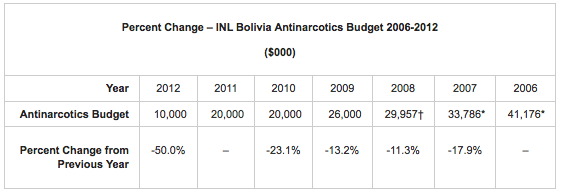
*Does not include the following categories: Border and Transportation Control, Money Laundering, Law Enforcement Restructuring (OPR, LEDP), Administration of Justice or Alternative Development.
†Does not include the Trafficking in Persons category.
Diplomatic Implications of Cuts Unclear
Both governments' drug policy rhetoric and practice differ widely. The U.S. continues to criticize the Morales government's stance on coca production, but also maintains a diplomatic presence in Bolivia, funding for antinarcotics efforts and limited alternative development projects to replace income from coca leaf production. The Bolivian government frequently makes claims about U.S. conspiracies in the region, often without providing clear supporting evidence. Yet some high–ranking officials still seek a revised bilateral framework agreement, and view ongoing aid to Bolivia as a U.S. obligation. For example, Vice President Alvaro Garcia Linera stated, "In the fight against drug trafficking there is a shared obligation, fundamentally [an obligation] of the consumer countries, and this help, that is not help, [but actually] a responsibility, should not decrease. It is [the U.S.'] obligation and responsibility."[ii]
If approved for 2012, it remains unclear what effect the cuts would have on the relationship and continuing U.S. government initiatives in Bolivia. Evidently this would imply a reduced agenda. In the past, the U.S. operated under the assumption that funding allowed its officials to assert influence over Bolivian government decisions, especially regarding drug control. This approach formed the premise of the annual drug control "certification" system. The Morales administration has challenged that model by moving away from forced coca leaf eradication as the primary control strategy and implementing alternative methods to control coca production. Although recent U.S. reports cite concerning increased trends in coca production, other sources such as the UNDCP cite smaller reductions, and Bolivia remains far behind Peru and Colombia with only 19 percent of total coca production in 2009.[iii]
Although Bolivia has assumed substantial economic responsibility for its coca and drug control programs, except for U.S. support significant international funding for these efforts has yet materialized. However, the Brazilian government recently signed an agreement to provide limited funding for Bolivian counternarcotics efforts, and consistently demonstrates its willingness to offer training and assistance for Bolivian counternarcotics efforts, especially along common borders.
Past Allotment of INL Funding
Based on the Executive budget requests, INL prepares and submits detailed international drug control budget proposals to Congress by February.[iv] Traditionally, the budget for Bolivia provided for interdiction, eradication, drug demand reduction, law enforcement training, infrastructure building and program development, as well as support for U.S. and Bolivian personnel. Other key allotments were designated to combat money laundering, trafficking in persons, and additional issues that gain prominence according to the U.S. agenda in the region. (See table below.) The 2012 executive summary does not provide a detailed breakdown of budget categories.
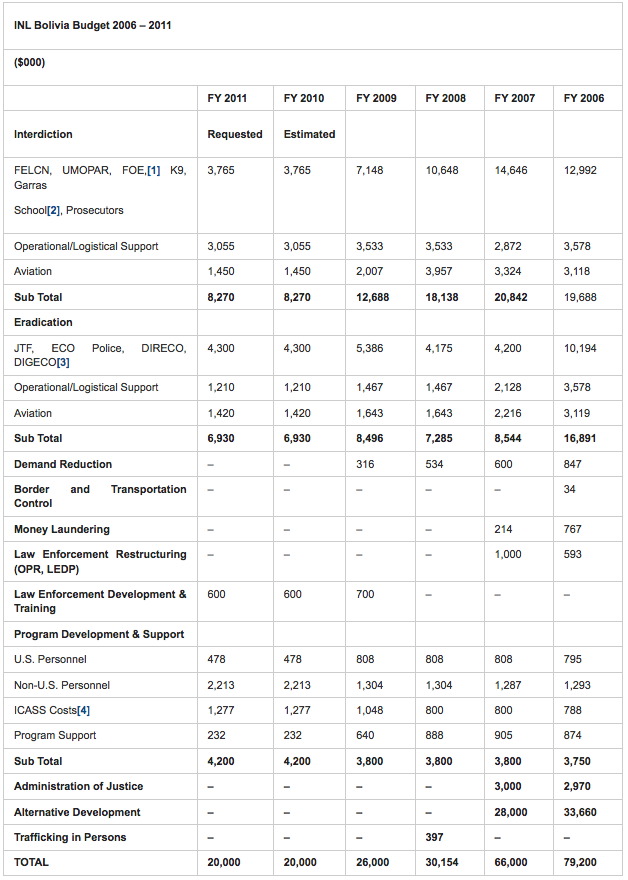
*In FY 2008, $397k from the International Narcotics Control and Law Enforcement (INCLE) account was allocated for Trafficking in Persons.
Note: In FY 2010, all Andean Counterdrug Program (ACP) funds were subsumed under INCLE.
Even before the U.S. government released proposed cuts for 2012, U.S. assistance gradually shrank. Yet, the percentage of the total budget for overhead costs and U.S. government employee salaries has steadily increased since 2006. This meant that, although the general trend in funding for Bolivia reflects an incremental decrease, in practice, reductions have been greater. Moreover, the percentage of the total Bolivia budget for Program Development and Support (PD&S) listed in the annual budget proposal has been consistently the same or lower than the actual amount spent for that category each year since 2006. In 2010, the PD&S allotment represented 16.2% of the overall request, but the estimated spending for last year shows that the same category actually utilized 21% of the total budget. The 2011 budget sustains that figure.
[Chart below appeared truncated in original]
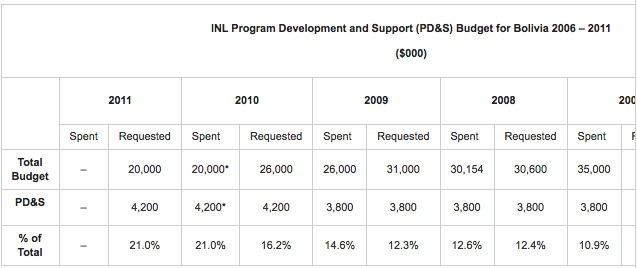
*Estimated amount.
Disproportionate Adjustments to Other Andean Nations' Aid
The U.S. drug control funding Bolivia receives is significantly less than the allotments for the two other countries that produce coca leaf, Peru and Colombia. The cuts proposed for Bolivia in 2012 are also more than double the reductions proposed for Peru and Colombia.
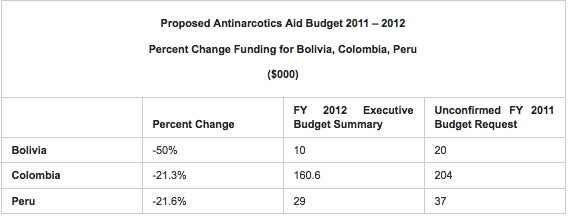
The counternarcotics reductions are part of broader funding decreases in Bolivia, including a drastic 72% cut in development funds, part of which are dedicated to alternative development. Although the Bolivian government has consistently asked for certain USAID programs to be removed, including democracy development, this cutback is not mirrored in other Andean countries. In fact, the 2012 proposal requests a 4% increase for Peruvian development aid.
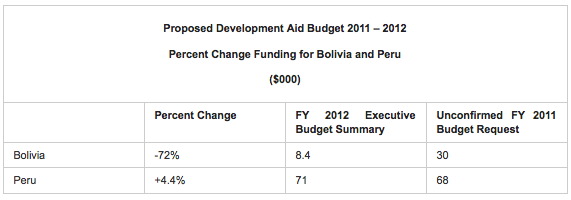
Again, these trends could imply political punishment or reward for cooperation with U.S. government policies. However, examining U.S. statistics on coca production for Peru and Bolivia reflect an apparent contradiction. The most recent U.S. International Narcotics Control and Strategy Report (INCSR) statistics listed an 8.5% increase in coca production for Bolivia, versus a 13.9% increase for Peru between 2007 and 2008.
Proposal Language Largely Consistent 2008-2011, Major Budget Cuts for 2012
In general, the language and tone used in the INL budget proposals from year to year varied little between the FY 2008 proposal and the FY 2011 document.[v] Some sections remained unchanged from year to year. The proposals echoed many other U.S. government documents, listing Bolivia as the "third largest producer of illicit coca and cocaine," without recognizing that Bolivia trails U.S. allies Colombia and Peru by wide margins, a distant third out of the only three coca-producing countries. The 2008-2011 documents also reflected ongoing concern about the expansion of Morales administration initiatives to increase the cap for licit coca production. INL proposals repeatedly highlighted the Yungas region as an area in need of further oversight and aid.[vi] Unbending attitudes repeated throughout these documents could perhaps have hinted at the cuts to come.
Although the 2012 Executive Budget Summary does not yet offer an itemized plan for funding, it proposes only $10 million for Bolivian counternarcotics efforts. The strategy for support also reflects significant change, as the one-paragraph proposal suggests "shifting costs for such programs as eradication to the Government of Bolivia…" and "seeking cost efficiencies with the Government of Bolivia."[vii] Overall, the clumsily worded paragraph leaves many questions unanswered.
FY 2008
- Without providing factual evidence, the document claims that, "…disengagement and withdrawal of USG resources would result in the rapid collapse of much of what has been achieved over more than two decades of USG financial and policy support."
- The proposal calls for revision of the Criminal Procedures Code, ironically a document that the USG previously helped develop for Bolivia as part of a regional USAID Administration of Justice initiative.
- In an apparent attempt to pin expanded coca production on President Morales, elected in December 2005, the document vaguely states, "USG cultivation estimates show an increase [in coca production] in most parts of the country in 2006."
- The proposal seemingly contradicts itself, both criticizing the Bolivian government's "permissive coca cultivation policy" and aiming to "help the GOB develop and implement its social communication policies related to counternarcotics activities."[viii]
FY 2009
- Criticisms continue in the subsequent document which claims that, "The policies of President Evo Morales, raise concern over the expansion of coca cultivation in Bolivia and the extent to which the GOB intends to cooperate bilaterally on counternarcotics." This line reappears the following year in the FY 2010 proposal.
- In addition, the report includes undiplomatic language: "This extensive support enables eradication and interdiction to operate effectively in the often primitive conditions that characterize Bolivia." Although the country is currently the second-poorest nation in South America, the U.S. government should avoid the use of racially-charged words like "primitive" in official documents.[ix]
FY 2010
- The document contradicts other U.S. government statistics, claiming: "An increasing proportion of the cocaine both transiting and produced within Bolivia is destined for Europe, Argentina, Brazil, Chile, Paraguay and Mexico (in the case of the last, probably for eventual sale in the United States)." However, DEA statistics show that less than 1 per cent of cocaine sold in the United States originates in Bolivia.[x]
- The budget revealed growing doubt about bilateral cooperation: "Budget allotments for FY 2010 reflect our concern over limited cooperation and political will from the GOB on eradication and on limiting new crops. Funding is primarily directed towards eradication support for operations the GOB is willing to undertake, such as in the national parks."
- The demand reduction program budget shrank and the U.S. personnel budget was increased for this proposal.
FY 2011
- The format changed significantly, eliminating the discussion of U.S. funded accomplishments, although all sections are abbreviated throughout the document.
- The document no longer specifies a net reduction in coca cultivation as an objective, instead stating: "In recent years, interdiction and eradication results have fallen as a result of GOB policies and actions, including the expulsion of the DEA in January 2009."
FY 2012 (Executive Summary)
- For the first time, this proposal refers to Bolivian "nationalization" of drug control efforts as a framework to stop paying key costs, such as eradication. It also mentions "reduced levels" of interdiction support.
- However, it proposes continuing aid for counternarcotics; police training; capacity building for law enforcement, public prosecutors, and the judicial system; human trafficking initiatives; and educational programs on drug trafficking and consumption.
- All of the historically important categories of U.S. INL aid to Bolivia seem to be maintained, although it is difficult to speculate how the budget will be specifically allotted in the face of a 50% cut.
Conclusions
It remains unclear why the U.S. government withheld major budget cuts for Bolivian aid until the 2012 budget proposal. Many policymakers have been continually frustrated by President Morales' repeated open criticism of U.S. aid, especially surrounding the 2008 expulsion of Ambassador Goldberg and the subsequent removal of the DEA.
During the Banzer-Quiroga administration (1997-2002), the U.S. government hoped to make Bolivia a case study for military participation and accelerated forced eradication, in an effort to promote their counternarcotics model. Since the election of President Morales, the Bolivian government has consistently rejected the U.S. approach and applied alternative coca reduction methods. At the same time, the ongoing U.S. strategy failed to reduce coca production in the Andean region, or significantly impact domestic availability and consumption of cocaine. This situation coincides with current U.S. need to scale back foreign budgets to address a soaring deficit and economic crisis at home.
However, both countries continue to affirm that they seek a more pragmatic diplomatic relationship. It is important that all sides seek agreement on a bilateral relationship less tied to funding, and establish realistic goals for coca control, drug interdiction and other initiatives appropriate to the Bolivian context. Compromise will be difficult for both governments because their agendas and capacity to achieve their objectives vary widely. The Bolivian government will have to seek funding from other nations to maintain its current level of counternarcotics intervention, or divert more of its own limited budget. On the other hand, the U.S. will have to objectively reevaluate its role with its main leverage for diplomatic influence cut by half if Congress approves the 2012 proposal. Dwindling U.S. funding and influence may, in the long run, provide an opening for a genuinely new form of bilateral
interaction.
[1] Bolivian elite forces supported by U.S. financial assistance: the Special Forces for Fighting Against Drug Trafficking (FELCN), the Rural Areas Mobil Police Unit (UMPOAR), and the Special Operations Force (FOE).
[2] A regional training school for specialized police and military forces that carry out counternarcotics activities.
[3] Bolivian eradication forces and control initiatives supported by U.S. financial assistance: Joint Task Force (JTF) a military-police coca eradication unit; the Ecological Police a security unit for eradication operations; DIRECO, now called UDESTRO, a coca reduction measurement and supervision unit.
[4] International cooperative Support Services The International Cooperative Administrative Support Services (ICASS) system is the principal means by which the U.S. Government provides and shares the cost of common administrative support at its more than 200 diplomatic and consular posts overseas. http://www.usaid.gov/gt/docs/icass.pdf
[i] See AIN and Wola's joint memorandum: "Decertifying Bolivia: Bush Administration "Fails Demonstrably" to Make its Case." 4 November 2008. < http://ain-bolivia.org/2008/11/decertifying-bolivia-bush-administration-%E2%80%9Cfails-demonstrably%E2%80%9D-to-make-its-case/>.
[ii] La Razón, "García: Ayuda antidroga es una obligación de Usaid." 9 December 2010. <http://www.la-razon.com/version.php?ArticleId=122294&EditionId=2371>.
"En la lucha contra el narcotráfico hay obligación compartida, fundamentalmente de los países consumidores, y esa ayuda, que no es ayuda, es responsabilidad, no debería disminuir. Es su obligación y su responsabilidad", dijo.
[iii] See AIN's memo, "The UNODC Coca Cultivation Study for Bolivia Shows Minimal Increase in Coca Crop: Sharply Contrasts with U.S. Statistics." 23 June 2010. <http://ain-bolivia.org/2010/06/the-unodc-coca-cultivation-study-for-bolivia-shows-minimal-increase-in-coca-crop-sharply-contrasts-with-u-s-statistics-2/>.
[iv] Government Printing Office. <http://www.gpoaccess.gov/usbudget/fy01/guide03.html>
The proposal for each following fiscal year mirrors the estimated spending to date at the time of the request. The actual amount spent, a figure that appears in the proposals two years after the spending occurred, tends to be lower than the requested amount and invariably matches the projected estimate. (See table below.)

[v] The basic format lists program objectives and initiatives, then runs through a justification for continued funding based on brief statistics outlining accomplishments from the previous year, and concludes with a proposal for the future year's personnel and operations.
[vi] It is also interesting to note that when the Chapare was the focus of U.S. concern about increasing coca production, U.S. government documents blamed coca growers and unions for this issue. However, now that the Yungas receive greater attention, the Morales government receives the brunt of criticism for failing to control expansion in that area. The U.S. government still fails to recognize its role in establishing licit and illegal zones for coca growth in Bolivia by writing the original Law 1008 that set these statutes.
[vii] FY 2012 Executive Budget Summary. 14 February 2012. <http://www.state.gov/s/d/rm/rls/ebs/2012/pdf/index.htm>.
[viii] Social control methods allow registered coca growers to produce one cato (40 m sq) of coca leaf, an agreement pre-dating the Morales administration. Although the U.S. continually criticizes this system, the Bolivian government carefully monitors registered coca plots and eradicates any areas of expansion.
[ix] This is a particularly sensitive topic in Bolivia, where recent legislation provides sanctions for discriminatory terminology.
[x] United States. "Bolivia: Counternarcotics News and Trends." United States Embassy Official Cable. La Paz: 17
December 2009. < http://213.251.145.96/cable/2009/12/09LAPAZ1784.html>